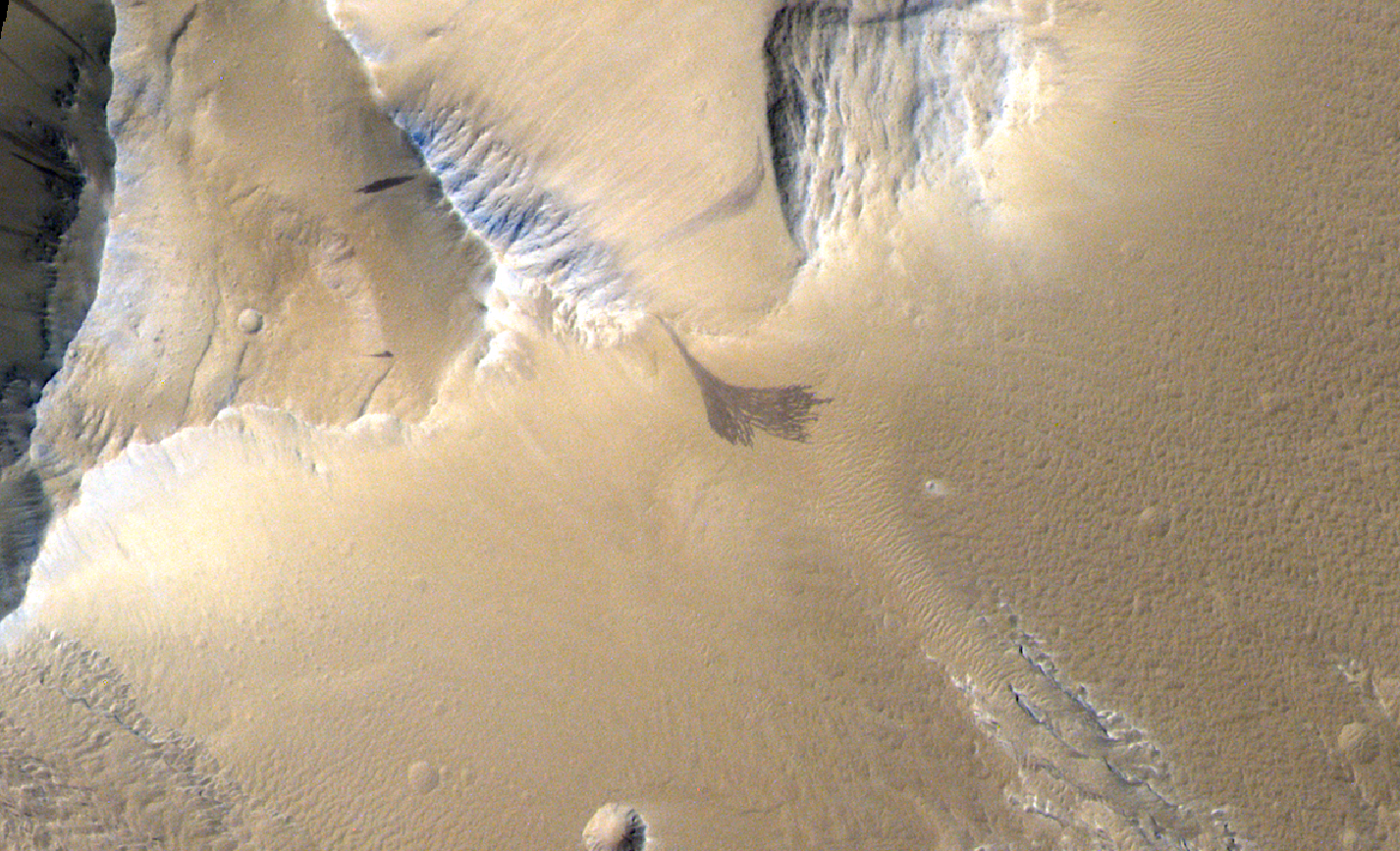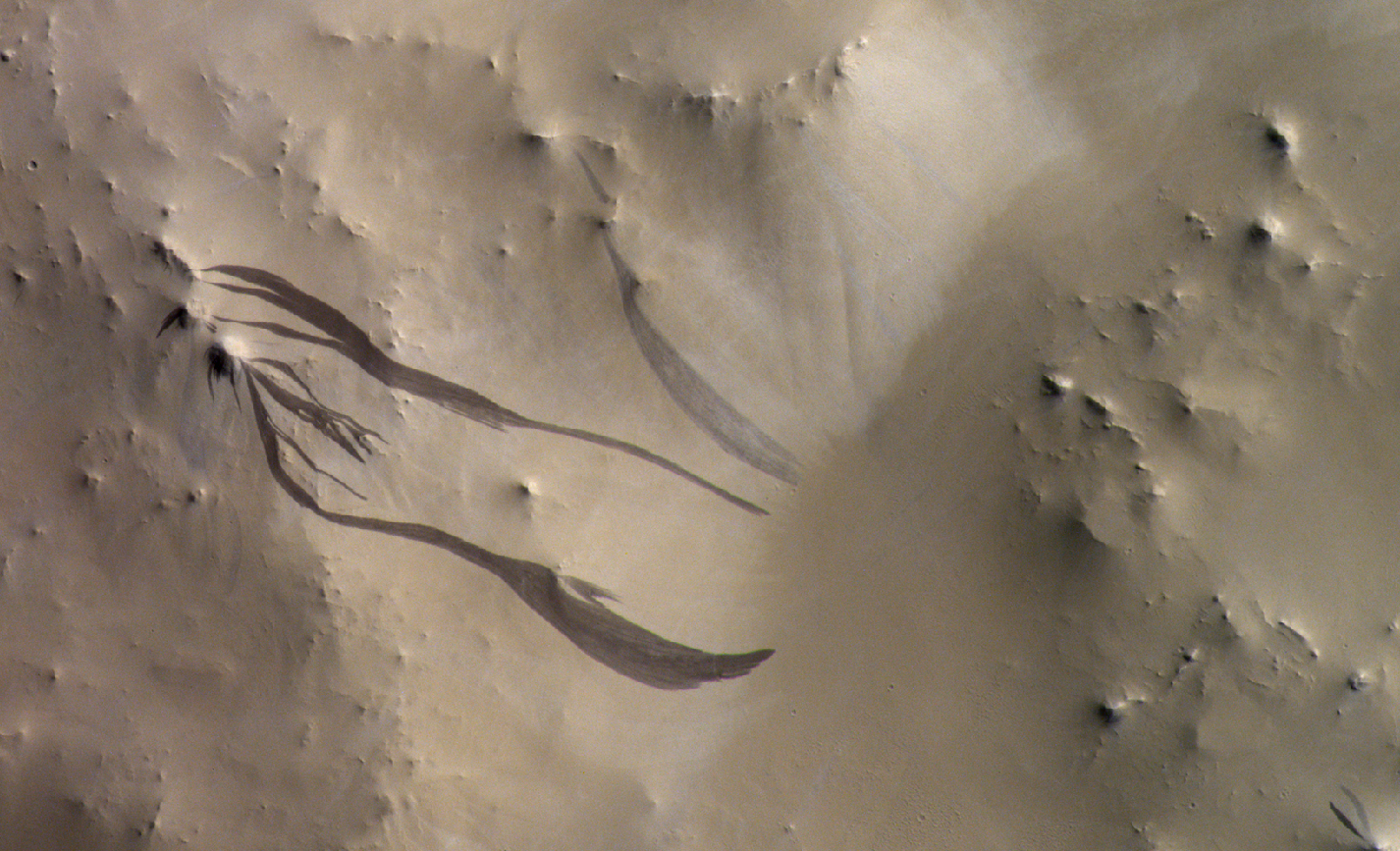These enigmatic features come and go spontaneously, some last for years while others quickly fade. They change colour and brightness and show up during certain seasons on opposite hemispheres of the Red Planet.
Scientists first saw these enigmatic streaks extending for hundreds of metres down sloped terrain in images from the Viking orbiters in the 1970s. How they form, where and when has fueled scientific debate ever since.

Streaks covering the slopes of a small crater in southern Amazonis Planitia. The image covers an area of approximately 50 square kms and was captured on 29 March 2021. Mars location: 7.6°N, 188.2°E. CaSSIS image MY36_014932_173_3. Credits: ESA/TGO/CaSSIS, CC-BY-SA 3.0 IGO
Wet versus dry origin
Some researchers have interpreted these streaks as flows of salty water, or brine, that could remain liquid long enough to form them. This hypothesis suggests rare habitable zones might exist on this otherwise desert world where temperatures rarely rise above freezing.
However, a new study led by planetary scientists at the University of Bern and Brown University challenges the water-based explanation. Their paper in Nature Communications argues that these slope streaks result from dry processes involving wind and dust activity.
Deep learning-powered research
Researchers turned to a machine learning algorithm to scan and catalogue slope streaks in over 86 000 satellite images from NASA’s Mars Reconnaissance Orbiter (MRO).
Scientists combined several decades’ worth of orbital data and the neural power of deep learning to produce a global map with almost 500 000 streak features across Mars. The new study created the largest database yet of these features on Mars.
“Once we had this global map, we could compare it to databases and catalogues of other parameters like temperature, wind speed, hydration, rockslide locations, and dust devil activity,” says Valentin Bickel, lead author of the study from the University of Bern, Switzerland.

Streaks covering the slopes of the Olympus Mons aureole. The image covers an area of approximately 50 square kms and was captured on 28 April 2023. Mars location: 15.2°N, 214.9°E. CaSSIS image MY37_024218_014. Credits: ESA/TGO/CaSSIS, CC-BY-SA 3.0 IGO
The team also turned to other cameras orbiting Mars, such as the CaSSIS imager on ESA’s Trace Gas Orbiter and MRO’s HiRISE, to collect more colour information in high resolution, as well as to monitor how the streaks evolved over time.
“The images from the European Mars orbiter are particularly useful in investigating these streaks. Our Trace Gas Orbiter can capture how the sun glints off the surface at all times of day, allowing us to study surface properties such as the size of dust grains and revealing the physical nature of the streaks,” explains Colin Wilson, ESA’s project scientist for the ExoMars Trace Gas Orbiter.
Triggers
The correlations over hundreds of thousands of cases helped the team shed new light on a decades-old debate. With no evidence of water, scientists concluded that dry processes – rather than liquid flow – drive the appearance of streaked slopes on Mars.
The study found that these winding features most likely form when layers of fine dust suddenly slide off steep terrain. Multiple triggers could unleash this process, such as rocks falling, small meteoroid impacts or wind gusts causing shockwaves and shaking loose dust.

Streaks covering the slopes of a crater in Terra Sabaea. The image covers an area of approximately 50 square kms and was captured on 6 June 2021. Mars location: 9.3°N, 39.7°E. CaSSIS image MY36_015777_009. Credits: ESA/TGO/CaSSIS, CC-BY-SA 3.0 IGO
To bring out these features, the contrast in these CaSSIS images is stretched – the image is re-scaled between the minimum and maximum brightness within each colour before combining them to produce the published image.
ESA’s ExoMars Trace Gas Orbiter continues to image Mars from orbit to understand its ancient past and potential habitability. The spacecraft returns spectacular images and provides the best inventory of atmospheric gases and mapping the planet’s surface for water-rich locations.
Understanding the history of water on Mars and whether it once allowed life to flourish is at the heart of ESA’s ExoMars missions.
- “Streaks on Martian Slopes are Dry,” by Valentin Bickel and Adomas Valantinas, published in Nature Communications, 19 May 2025.
- “CaSSIS color and multi-angular observations of Martian slope streaks,” by Adomas Valantinas et al., published in Planetary and Space Science, 2021.

Discussion: no comments